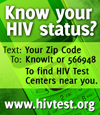Transmission Prevention
General Information
Barrier Products Articles from the FDA (Food and Drug Administration)
A listing of articles provided by the FDA for barrier products used in the transmission prevention of HIV including articles on condoms and gloves, as well as a discussion about latex allergies associated with some barrier products.
HIV and AIDS: Are You at Risk? (Centers for Disease Control and Prevention)
Provides basic information about HIV and AIDS, the behaviors that place people at risk for HIV and preventive measures everyone can take to prevent HIV.
HIV and Its Transmission (Centers for Disease Control and Prevention)
This fact sheet provided by the Centers for Disease Control and Prevention provides information on the clearly identified ways HIV transmission occurs based medical, scientific, and public health research to counter false information or statements that are not supported by scientific findings continue to be shared widely through the Internet or popular press. En español
HIV/AIDS Prevention (National Library of Medicine, NIH)
A listing of prevention information resources collected by the National Library of Medicine’s Specialized Information Services. Resources are organized by category.
HIV/AIDS Prevention Today (National Prevention Information Network, CDC)
This resource created by the CDC’s National Prevention Information Network (NPIN) provides information on why prevention is important in the fight against HIV/AIDS, how individuals can prevent transmission, and activities the CDC is undertaking to help stop the transmission of HIV/AIDS.
How to Protect Yourself from AIDS (Food and Drug Administration)
This resource prepared for the general public provides a brief overview on different ways to prevent the transmission of HIV. En Español
Prevention – Women and HIV/AIDS (Office on Women’s Health)
This site provides basic prevention information, including the steps individuals can take to prevent themselves from getting HIV. The site also provides prevention information specific to women and their needs, as well as tips and guidance on how to talk to children about HIV.
Understanding HIV Prevention (PDF - 53 KB) (AIDSinfo)
Fact sheet providing information people with HIV need to know to avoid infecting others. En español (PDF - 56 KB)
Prevention Programs
Advancing HIV Prevention: New Strategies for a Changing Epidemic (Centers for Disease Control and Prevention)
The Advancing HIV Prevention: New Strategies for a Changing Epidemic initiative aims to reduce barriers to early diagnosis of HIV-infection and increase access to quality medical care, treatment, and ongoing prevention services for those living with HIV. The goal of the program emphasizes HIV testing to help identify persons who are not aware of their own HIV infection, and facilitate getting them into treatment and prevention services.
AIDS Community Demonstration Projects: A Successful Community-Level Intervention to Reduce HIV Risk (Centers for Disease Control and Prevention)
Designed primarily for HIV prevention community planning groups and program planners in state and local health departments, community-based organizations, and other agencies, this program provides valuable information about a peer outreach model that was successful in motivating adoption of reduced risk practices among several populations.
Centers for Disease Control and Prevention (CDC) Prevention Program (Centers for Disease Control and Prevention)
Recommendations and Guidelines for prevention of HIV/AIDS from Centers for Disease Control and Prevention.
HIV Cost Effectiveness (Centers for Disease Control and Prevention)
Cost effectiveness has long been a criterion in setting HIV program priorities. The basic principle is straightforward: choose those options that provide the greatest outcome for the least cost.
Replicating Effective Programs Plus (Centers for Disease Control and Prevention)
This program organized by the CDC is dedicated to helping individuals identify and implement HIV/AIDS prevention programs that are tested, science-based behavioral interventions with demonstrated evidence of effectiveness in reducing risky behaviors.
Health Care Workers
Health Care Worker Exposure Guidelines (AIDSinfo)
A Morbidity and Mortality Weekly Report (MMWR) titled "Updated U.S. Public Health Service Guidelines for the Management of Occupational Exposures to HIV and Recommendations for Postexposure Prophylaxis."
Specific Populations
HIV/AIDS and Pregnancy (National Library of Medicine - MedlinePlus, NIH)
A list of resources on HIV and pregnancy.
Drugs + HIV – Learn the Link (National Institute on Drug Abuse)
The Drugs + HIV – Learn the Link initiative communicates that behaviors associated with drug abuse are among the main factors in the spread of HIV infecting in the United States, and provides information for young people, parents and teachers, and the media.
Pregnancy and Childbirth (Centers for Disease Control and Prevention)
This resource outlines the special issues surround HIV/AIDS transmission prevention during pregnancy and childbirth. The goals of the program are to ensure that pregnant women and their health care providers discuss the importance of HIV testing during pregnancy; to make voluntary HIV testing available to pregnant women; and to ensure that HIV-infected women and HIV-exposed infants have access to appropriate prevention interventions.
Principles of HIV Prevention in Drug-Using Populations (National Institute on Drug Abuse, NIH)
A research based guide which provides the basic overarching principles that characterize effective HIV/AIDS prevention in drug users. En español
Women and HIV/AIDS, Prevention (Office on Women's Health)
This resource provides prevention information specifically for women. The Office for Women's Health (OWH) was established in 1991 within the US Department of Health and Human Services. OWH coordinates the efforts of all the HHS agencies and office involved in women's health.





 Did you know that behaviors associated with drug abuse are among the main factors in the spread of HIV infection in the United States?
Did you know that behaviors associated with drug abuse are among the main factors in the spread of HIV infection in the United States?